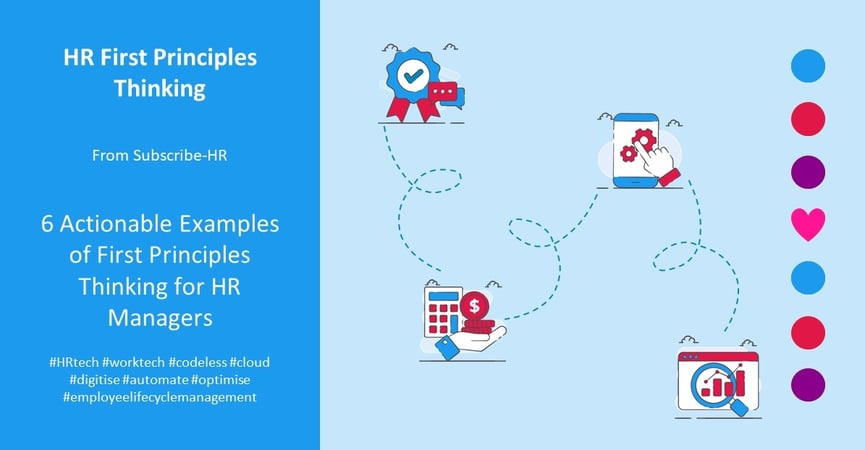Calling all HR professionals who struggle in confident decision-making and problem-solving – we’ve got something that might help.
We’ve all been faced with trying to use systems and principles that don’t actually make sense. Maybe the methods we’ve been using to solve problems aren’t that powerful after all.
Cue First Principles thinking, a way of reframing complex problems and bringing the best solutions possible to the table.
The first principles model is incredibly powerful for HR leaders to achieve way more clarity and consistently find efficient solutions to the problems they face daily.
In this blog post, we’ll be discovering what first principles thinking is all about and how you can apply it to HR. Read on for actionable examples and insights into just how powerful it can be! 👍

First Principles Thinking: What is It?
First Principles Thinking is a mental framework that encourages us to deconstruct problems and ideas into their most fundamental components. In other words, it is a methodical approach that involves stripping away assumptions and examining the foundational truths at the heart of a concept.
First principles thinking starts with the idea that problems have layers – they are made of assumptions, conventions, and accepted practices. The model encourages us to take a step back and question the very nature of problems. It's a process of breaking down complexity to reach a level of understanding where solutions can be built from the ground up, unencumbered by preconceived notions.
This approach, often attributed to Aristotle and later popularised by Elon Musk, fosters a mindset of curiosity, creativity, and a willingness to push beyond the boundaries of conventional thinking. 🙌
The benefits of First Principles Thinking
- Fueling creativity: First Principles Thinking promotes creativity by encouraging individuals to break away from conventional wisdom and explore novel solutions based on foundational truths
- Adaptability: Solutions derived from First Principles Thinking are inherently adaptable. They are not bound by existing norms, which makes them more flexible and responsive to changing circumstances
- Effective problem-solving: Tackling challenges at their core allows for more effective problem-solving. Rather than addressing symptoms, First Principles Thinking targets the root causes of issues
- Questioning assumptions: This method encourages the identification and questioning of assumptions, reducing the impact of bias and promoting objective, evidence-based decision-making
- Informed decision-making: Organisations can make more strategic decisions by applying First Principles Thinking to business strategies, product development, and operational processes
- Empowering people: HR leaders that employ First Principles Thinking take ownership of problems, as they are actively engaged in understanding and addressing the core issues rather than relying on predefined solutions
- Cross-disciplinary potential: First Principles Thinking is not confined to specific domains; it can be applied across various disciplines, fostering interdisciplinary creativity and problem-solving
- Cultivating excellence: This approach encourages a culture of continuous improvement by challenging the status quo, fostering a mindset of curiosity, and driving ongoing innovation

Using First Principles Thinking step-by-step
Step 1: Identify assumptions
The first step in First Principles Thinking requires a deliberate effort to uncover and question the assumptions that often lurk in the shadows of a given problem.
Even though these assumptions are often deeply ingrained and overlooked, they can end up significantly influencing our understanding and approach to solving problems.
When you’re able to shed light on these hidden beliefs, you’re not only acknowledging their existence but you’re setting up a foundation for analysing and reframing them.
Step 2: Break down the problem

Once you’re fully aware of those underlying assumptions in the problem you’re facing, you can break down the problem into components.
A good method here is to visualise the problem as a puzzle and determine which aspect of the problem forms different pieces of the puzzle. This will usually look something like:
Problem
Component 1 – a specific aspect of the problem
Component 2 – a specific aspect of the problem
Component 3 – a specific aspect of the problem
Component 4 – a specific aspect of the problem
(and so on)
Step 3: Reevaluate principles
With a detailed breakdown of the problem you’re facing in hand, you can turn your critical gaze towards the principles that traditionally guide decision-making.
Think about the principles that govern the problem and how relevant they are to your context ⬇️
- Are these principles still valid?
- Have circumstances evolved?
- Can alternative approaches better align with the core truths revealed during the deconstruction phase?
Step 4: Build solutions from the ground up
Now that you have a fresh perspective and a deep understanding of the core components and principles, the final step is to build innovative solutions.
Instead of relying on established practices, you are now empowered to build solutions from the ground up. This involves aligning your strategies with the fundamental truths uncovered during the First Principles Thinking process.
It's a transformative phase where abstract ideas evolve into tangible, forward-thinking strategies. Here, you have the opportunity to reshape outcomes, challenge conventions, and drive meaningful change in your approach to problem-solving. 👍
How to Apply First-Principles Thinking to HR

6 actionable examples of First-Principles Thinking in HR
Example 1: First-Principles thinking for talent acquisition
The problem
The talent acquisition process relies heavily on traditional hiring methods, assuming that the best candidates possess specific educational backgrounds or industry experience.
Step 1: Identify assumptions
- Challenge the assumption that the best candidates must have a specific educational background or industry experience
- Analyse past hiring patterns to identify the implicit assumption
- Recognise that the assumption may limit the diversity of the talent pool
- Acknowledge the existence of the assumption as a basis for objective analysis
Step 2: Break down the problem
Problem: Traditional hiring methods rely on specific educational backgrounds and industry experience, limiting diversity
Component 1: Dependence on educational backgrounds
Component 2: Reliance on industry experience
Component 3: Limited diversity in the talent pool
Step 3: Reevaluate principles
- Question the principle that hiring should follow traditional, generic methods
- Consider unconventional qualifications and experiences to broaden the perspective on what makes an ideal candidate
Step 4: Build solutions from the ground up
✅ Build recruitment processes based on the fundamental truths identified, fostering adaptability
✅ Develop a hiring strategy that accommodates a diverse range of backgrounds and perspectives
Example 2: First-Principles thinking for performance reviews
The problem
Performance reviews are often perceived as routine assessments rather than purposeful evaluations aligned with both individual and organisational goals.
Step 1: Identify assumptions
- Challenge the assumption that performance reviews are primarily routine assessments
- Deliberately examine whether current processes align with individual and organisational goals
- Acknowledge the assumption that feedback is secondary to the assessment
- Recognise the existence of the assumption as a basis for objective analysis
Step 2: Break down the problem
Problem: Perception of routine assessments
Component 1: Perception of routine assessments
Component 2: Lack of alignment with individual goals
Component 3: Lack of alignment with organisational goals
Component 4: Inadequate meaningful feedback
Step 3: Reevaluate principles
- Question the principle that performance reviews should follow standardised processes
- Consider principles that allow for continuous feedback and adaptation of assessment strategies
Step 4: Build solutions from the ground up
✅ Build a performance evaluation system that aligns with individual contributions
✅ Construct a system that integrates continuous feedback, fostering professional growth
Example 3: First-Principles thinking for employee engagement
The problem
Employee engagement initiatives are often designed based on assumptions about what superficially motivates and satisfies employees. The challenge lies in identifying and addressing the fundamental factors contributing to genuine satisfaction and productivity, which can easily be overlooked in conventional approaches.
Step 1: Identify assumptions
- Question assumptions about what superficially motivates and satisfies employees
- Examine whether current engagement initiatives authentically address fundamental factors
- Acknowledge the assumption that engagement can be measured solely through traditional metrics
Step 2: Break down the problem
Problem: Assumptions about motivators
Component 1: Assumptions about motivators
Component 2: Potential mismatch between assumed and actual motivators
Component 3: Overlooking fundamental factors
Component 4: Engagement initiatives may lack authenticity
Step 3: Reevaluate principles
- Question the principle that engagement initiatives should follow conventional, one-size-fits-all approaches
- Consider principles that allow for continuous feedback and adaptation of engagement strategies
Step 4: Build solutions from the ground up
✅ Construct engagement initiatives based on the identified fundamental factors
✅ Build a system that dynamically measures the impact of engagement initiatives
Example 4: First-Principles thinking for flexible work arrangements
The problem
Traditional work structures, assuming a 9-to-5 office routine, may not align with the core needs of employees. The challenge is to recognise and accommodate these essential requirements by reevaluating assumptions about work arrangements and building flexibility into the organisational framework.
Step 1: Identify assumptions
- Challenge the assumption that a traditional 9-to-5 office routine is necessary
- Deliberately examine whether current structures align with the core needs of employees
Step 2: Break down the problem
Problem: Assumption of a 9-to-5 office routine
Component 1: Assumption of a 9-to-5 office routine
Component 2: Lack of alignment with core needs
Component 3: Rigidity in work arrangements
Component 4: Potential dissatisfaction due to inflexible structures
Step 3: Reevaluate principles
- Question the principle that work structures should follow traditional norms
- Consider principles that allow for the tailoring of solutions based on identified core needs
Step 4: Build solutions from the ground up
✅ Try flexible work arrangements that accommodate the essential requirements of employees
✅ Build a system that supports both individual and organisational goals more optimal flexibility
Want to find out more about HR strategies? Check out our free guide to HR storytelling!

FAQs – Frequently Asked Questions
What is First Principles Thinking, and how does it apply to HR?
First Principles Thinking involves breaking down complex problems into their fundamental truths and building solutions from the ground up. In HR, it means challenging assumptions and traditional practices, fostering innovation and adaptability in talent management, and employee engagement.
Why should HR professionals care about First Principles Thinking?
HR professionals face evolving challenges, and First Principles Thinking offers a systematic approach to problem-solving. By questioning assumptions and reevaluating principles, HR can create more effective and tailored solutions, fostering a culture of continuous improvement.
How can I implement First Principles Thinking in my HR practices?
Start by identifying assumptions in your processes, breaking down problems into fundamental components, questioning existing principles, and then building solutions based on core truths.
Is First Principles Thinking only applicable to specific HR functions?
No, First Principles Thinking is versatile and can be applied across various HR functions, including talent acquisition, performance reviews, employee engagement, flexible work arrangements, training and development, and diversity and inclusion. It encourages interdisciplinary creativity and problem-solving.
How does First Principles Thinking promote diversity and inclusion in HR?
HR can identify core principles that genuinely foster an inclusive culture. This may involve questioning existing diversity initiatives and ensuring they authentically address the multifaceted nature of diversity and inclusion.
Can First Principles Thinking be applied to small and large organisations alike?
Absolutely. First Principles Thinking is not confined to organisation size. It's a mindset that encourages creative problem-solving and can be adapted to suit the specific needs and challenges of both small and large organisations.
Is there a risk of overhauling existing HR practices completely with First Principles Thinking?
While the goal is to challenge and improve existing practices, the implementation of First Principles Thinking can be gradual. It's about refining and adapting, not necessarily discarding everything. HR professionals can start with small changes and iterate based on feedback and outcomes.
How can First Principles Thinking contribute to employee satisfaction and retention?
By uncovering fundamental factors that drive satisfaction and productivity, HR can tailor engagement initiatives to authentically address employee needs. This targeted approach enhances job satisfaction, contributing to increased employee retention and overall well-being.
Can First Principles Thinking be applied to ongoing HR challenges, or is it a one-time solution?
First Principles Thinking is a continuous process. It encourages a culture of continuous improvement and adaptability. HR professionals can use it to address ongoing challenges and ensure that their practices evolve in response to changing circumstances.
Are there any specific industries where First Principles Thinking is more beneficial in HR?
First Principles Thinking is beneficial across various industries. Its adaptability allows HR professionals to tailor solutions to the specific needs of their industry, fostering innovation and resilience in the face of industry-specific challenges.

